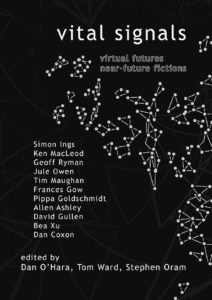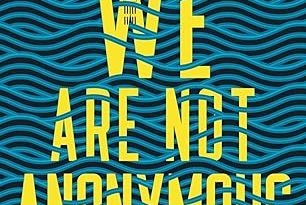Vital Signals: Virtual Futures, Near-Future Fictions edited by Dan O’Hara, Tom Ward & Stephen Oram (book review).
‘Vital Signals’ has thirty stories in two hundred pages, so that’s about six pages per yarn, but it’s a bit less because there’s an introduction and some blank pages where a new section begins. So these are short, sharp shocks but more Thatcher than Gilbert and Sullivan because they are generally unpleasant.
The significance of the stories lies in their implications. The book divides into four sections based on themes: ‘Virtual Persons’, ‘Post-Brain’, ‘Disease’, and ‘Conflict’. I’ll quote the editors’ definitions for each theme and pick my favourites. Your favourites will be different because that’s how anthologies work.
Virtual Persons
‘Virtual Persons explores the ways in which new forms of embodiment could influence how different aspects of our society operate – from the legal system to waging war to socialising – which pertains to current concerns about the ways in which social media and virtual reality may affect our personhood.’ The following two tales stood out for me.
‘The Test’ in a story by C.R. Dudley compares your real personality to your online persona, the latter usually being more extroverted and agreeable. If your real personality fails the test, you’re a fake and don’t get the gold star emoji that guarantees advertising, crowdfunding and all the other benefits of being successful. Chilling, but this really is the future.
In ‘Conjugal Frape’ by Jamie Watt, Dave crafts a bespoke social media strategy for clients who are keen to join the 1%, the Primary. You need 10 million followers to join the primary. This is about post-truth society and the stupidity and gullibility of the 99%. In the present, a beautiful lady will quit her medical studies because she can make ten times as much money shaking her ass on ‘OnlyFans’, so, sadly, both these stories felt like the very near future.
Post-Brain
‘Post-Brain aims to investigate how technological augmentations may impact traditional human mental processes as well as postulate entirely different forms of consciousness – exploring concerns in the relatively nascent field of cognitive neuroscience.’
‘Biohacked And Begging’ by Stephen Oram features a unified sentience where we can all share each other’s thoughts and feelings in true empathy. As Bartleby the Scrivener said, ‘Really, I would prefer not to.’
In ‘Forever Live’ by Mark Huntley-James, you can encrypt your memories before death for your family to enjoy.
‘A Letter From My Celia’ has a message to ‘grasping, profit-driven, low-intelligence, self-obsessed humans’ from another species. You’ll never guess which one. If a man wrote this, I’d say he was a fun guy, but author Jane Norris is a clever lady.
‘Anomaly In The Rhythm’ by Viraj Joshi is set in London in 2085, where all the trains and buses run on time, and so do the well-organised people, thanks to LimbPlus, a glove that directs individuals to co-ordinate harmoniously with each other. Miss Sally Pennington goes astray. All these futures are scary in their different ways.
Disease
‘Disease homes in on the potential infections, contagions and healthcare systems that could be created by the cross-pollination of advanced technologies and all-too-human biologies – which was inspired by concerns about the pharmaceutical industry and the potential for new forms of pestilence in our highly connected world.’
In ‘Do Not Exceed Stated Dose’ by Allen Ashley, Mrs Carmel goes to Dr Phillips to get some pills for her hypersensitivity to electronic airwaves. But those make her sleepy, so she needs others to perk her up, but those upset her tummy and so on. Phillips is the sort of doctor who will give the patient anything for money. Phillips is the sort of doctor who will give the patient anything for money. The sort of doctor Elvis, Prince and Michael Jackson had. While this may not reflect the current state of affairs in England, the future remains uncertain.
Some fruit flies carry on as if alive for a while after their heads are chopped off. ‘Not Best Pleased’ by Geoff Ryman is a nice bit of black humour in which sloppy student Todd messes up a ‘zombie’ fruit fly experiment with interesting consequences.
‘An Honest Mistake’ by Tom Ward packs a big scare into very few pages. TrEATit is the world’s first bacterial processing plant where genetically engineered Mastics eat plastics, so at last we can dispose of them safely. But the clever scientists forgot something.
‘The Needs of the Few’ by Jennifer Rohn tells the story of antibacterial resistance in human terms. Rose is a doctor who lost her job in Big Pharma and now harvests algae twice daily by the seaside when the tide recedes. I enjoyed the little Spock homage in the title and a sly dig at homoeopathy in the contents. It’s water, folks.
‘The War That Ended Yesterday’ by David Turnbull has the war to end all wars told succinctly in dialogue. Since the story features a biological weapon, it might have been more suitable for the next section, but it is likely more appropriate in this context. Although the central idea of mass amnesia is not new, the way it is presented here is sure to make you smile.
Conflict
‘Conflict seeks to analyse the ways in which technologies promote, resolve or alter all forms of conflict, from the interpersonal to the international – which is related to the current debate concerning the increasingly adverse environments new media promotes and the intersection of the technological and military-industrial complex.’
Although most stories in this section did not capture my interest, there were two that I liked for different reasons. ‘The End of War’ by Jule Owen has the Russian Secret Service AI take over the world and fool around with humans who don’ know it’s in charge. The story was fun. I’m hoping that a benevolent AI will take over and run things for us one day. The situation could not be more dire than it currently is.
‘Safe From Harm’ by Tim Maughan struck a chord because it was set in my home city of Bristol, England, and featured an old man who hoarded media, everything from books, comics and newspapers to DVDs and vinyl. Tyrone and Bags, a pair of foul-mouthed petty thieves from the inner city, break into a terraced house in Lawrence Hill where the rooms are stacked high with stuff, barely leaving a narrow corridor for access. Digital culture has all gone after the crash, so this pile of trash is now precious, and the government wants it. But doesn’t a private citizen have rights? This may come true, and I know at least four old men who have not gone digital and have rooms lined with stuff. I’m sure there are many more.
‘Vital Signals’ is an excellent collection of brief stories that typically convey a clever idea, encouraging you to reflect on the future world. None of them will stick long in the memory, I suspect, but short stories are to be enjoyed in the moment. A lot of work and thought by clever people has gone into this anthology, and it’s definitely worth a look.
Eamonn Murphy
June 2025
(pub: Newcon Press, 2022. 206 page small enlarged paperback. Price: £12.99 (UK). ISBN: 978-1-914953-09-5. Kindle: £ 3.99 (UK))
check out website: www.newconpress.co.uk




